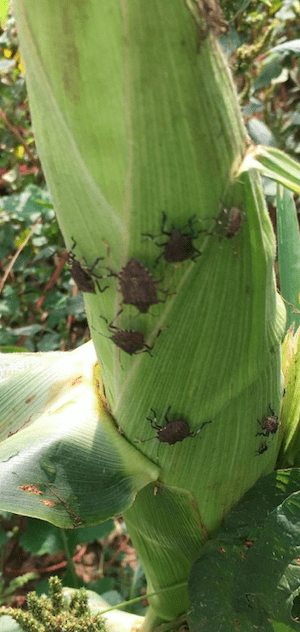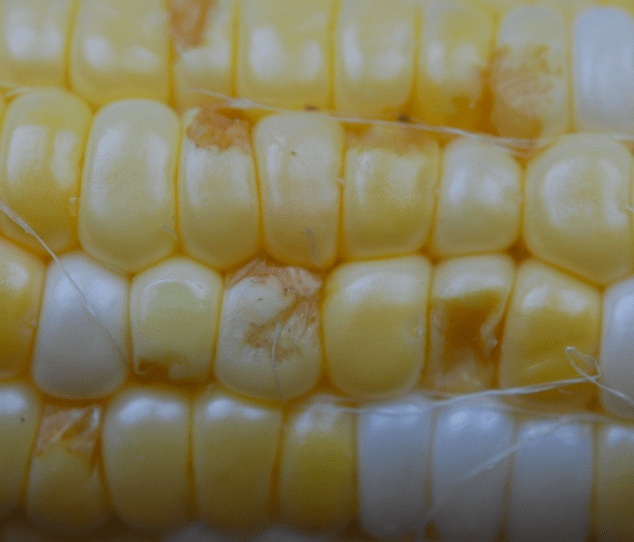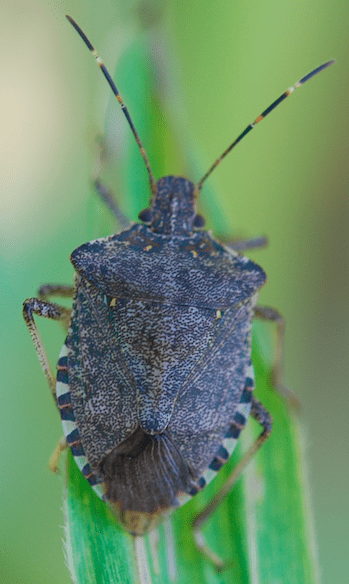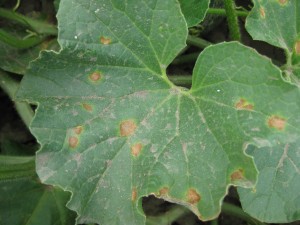Wayne County IPM Notes
Vegetable Pests

Aphids feeding on the under side of a pumpkin leaf. F. Becker photo.
In many crops, I am starting to see aphids feeding on the underside of the leaves. Most consistently, I have seen this in pumpkins. The aphids cause direct damage to the leaves via their feeding, but they can also cause other issues such as the sooty mold that happens as a result of their exudate known as honeydew. Additionally, aphids can potentially transmit viruses from plant to plant.
Flea beetles are still a problem in both young, recently transplanted crucifer crops, as well as cabbage and kale either in harvest or near harvest. Feeding damage from flea beetles on the younger crops can cause stunting and reduced yield. This damage can be especially impactful on heat stressed transplants. The foliar feeding being done on maturing crops can affect the visual appearance of the crop and may result in a less desirable product.
In cucurbit crops, the main pests causing problems are cucumber beetles and squash bugs. The cucumber beetle and their larvae can be found causing damage to both pumpkin and melon skins throughout the fields. Squash bug eggs are starting to hatch, and I am starting to find various stages of nymphs out in pumpkin fields and squash plantings. Currently most feeding is being done on the leaves; however, the focus of the feeding can shift to the fruit and cause scarring to the skin resulting in decreased marketability. The squash bug has also been found to be the vector of a bacterium that causes the disease Yellow Vine Decline.
Vegetable Diseases
Downy Mildew is in Wayne and Medina counties and likely in surrounding counties as well. Cucumber growers need to be spraying for downy mildew.

Sweet corn ear with large smut galls. F. Becker photo.
As tomato plants put on more foliage, the airflow between plants is restricted, which results in higher moisture environments within the plants. This high moisture environment is conducive for several fungal infections such as Septoria leaf spot and early blight. Both of these diseases are currently becoming more prevalent in field tomato plantings. This is also happening after a few heavy rains where soil was splashed onto the lower leaves.
Powdery mildew can be just as destructive on squash as downy mildew is on cucumbers. I have been finding powdery mildew consistently in younger squash plantings. Unfortunately, the earlier the plant is infected with powdery mildew, the shorter the life span of the plant. With an infected plant having a short life span, the yield for the plant can also be expected to decrease.
Sweet corn growers have been finding a lot of smut on the ears and sweet corn plants. Smut is more common during hot and dry weather, especially when followed by a heavy, warm rain. This year has been the perfect year for prime smut infection and growth.
Fruit Pests
Japanese beetles are still feeding in nearly every crop that I am scouting. They are doing damage to apple leaves, peach leaves, grape leaves, blueberry leaves and blueberry fruit. It is important to watch the populations of Japanese beetles because they can transition from only feeding on the leaves to doing significant damage to the fruit.
In orchards I am seeing an increase in spider mite populations. This includes two spotted spider mites and European red mites. These mites, while not causing major damage initially, can cause significant damage over prolonged periods of feeding.
Spotted wing drosophila have been active in small fruits for some time, but with peaches starting to ripen, the SWD can and will target the peaches as well. I found a handful of ripe peaches this week with soft spots on them. Upon peeling the skin back, I could clearly see several SWD larva feeding in the peach.
There was a short time of limited codling moth and oriental fruit moth activity, however, the traps again picked up high counts of both moths this week.
Fruit Diseases
Overall, disease pressure has been fairly limited this year. Hot and dry conditions have prevented favorable conditions needed for disease development. As fruit continues to ripen and be

Some grape varieties are nearing harvest. F. Becker photo.
harvested, we continue to move forward through the growing season without many disease issues in our area.
Apple and peach growers should continue their spray programs to manage fruit rots and diseases such as flyspeck and sooty blotch in apples and brown rot in peaches. Alternaria leaf blotch can be found on some apple trees right now. This can be made worse by red mite infestations. With high populations of mites and the leaf blotch, severe defoliation can occur.
Grapes should be starting to get some color to them as the clusters are starting to increase in size. Although symptoms of black rot may be showing up on untreated grapes, it is too late to do anything. Growers with varieties of grapes that are not resistant to downy mildew should consider a spray program. Grape growers should also keep an eye out for powdery mildew, as this is the time of year when powdery mildew is typically found on grapes.
























